Risk Management Program Analysis: Healthcare Quality and Risk
VerifiedAdded on 2022/08/21
|8
|1926
|23
Report
AI Summary
This report provides a comprehensive analysis of a healthcare organization's risk management program. It begins by examining the role of the organization's MIPPA-approved accreditation body, such as the Joint Commission, in ensuring quality improvement and effective risk management strategies. The report then delves into the roles and responsibilities of different levels of administrative personnel within the enterprise risk management department, highlighting their contributions to establishing and sustaining employer/employee-focused organizational risk management strategies and operational policies. The analysis further explores how the organization's quality improvement processes support and contribute to its overall journey to excellence. Additionally, it examines how the organization's risk management and compliance programs uphold ethical standards, and the legal and ethical responsibilities healthcare professionals face in upholding risk management policies and administering safe healthcare. Finally, the report identifies the challenges in risk assessment and the best practices that the organization should implement to manage risks effectively. The report is designed to assist a community health organization in developing its own risk management policies and procedures.
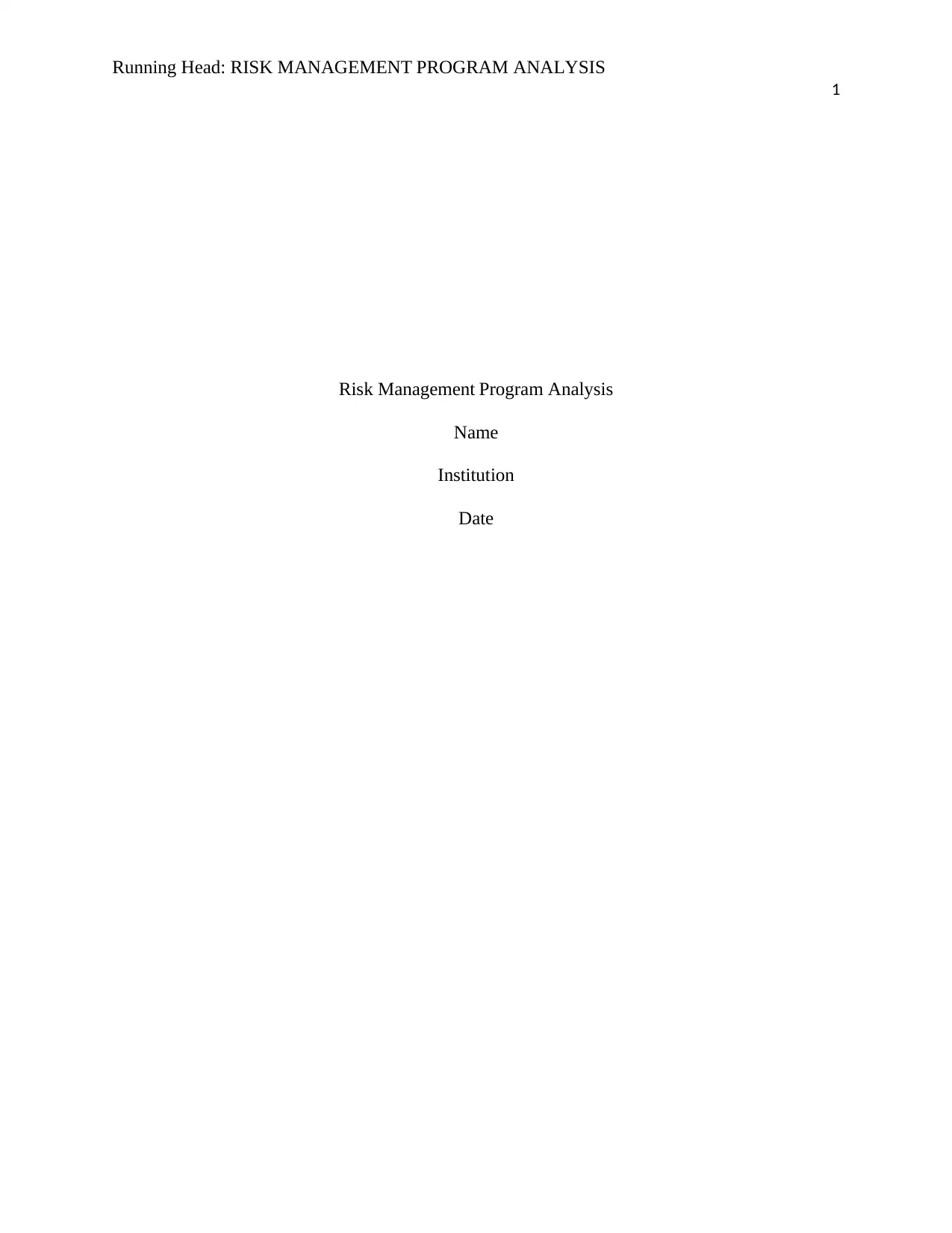
Running Head: RISK MANAGEMENT PROGRAM ANALYSIS
1
Risk Management Program Analysis
Name
Institution
Date
1
Risk Management Program Analysis
Name
Institution
Date
Paraphrase This Document
Need a fresh take? Get an instant paraphrase of this document with our AI Paraphraser
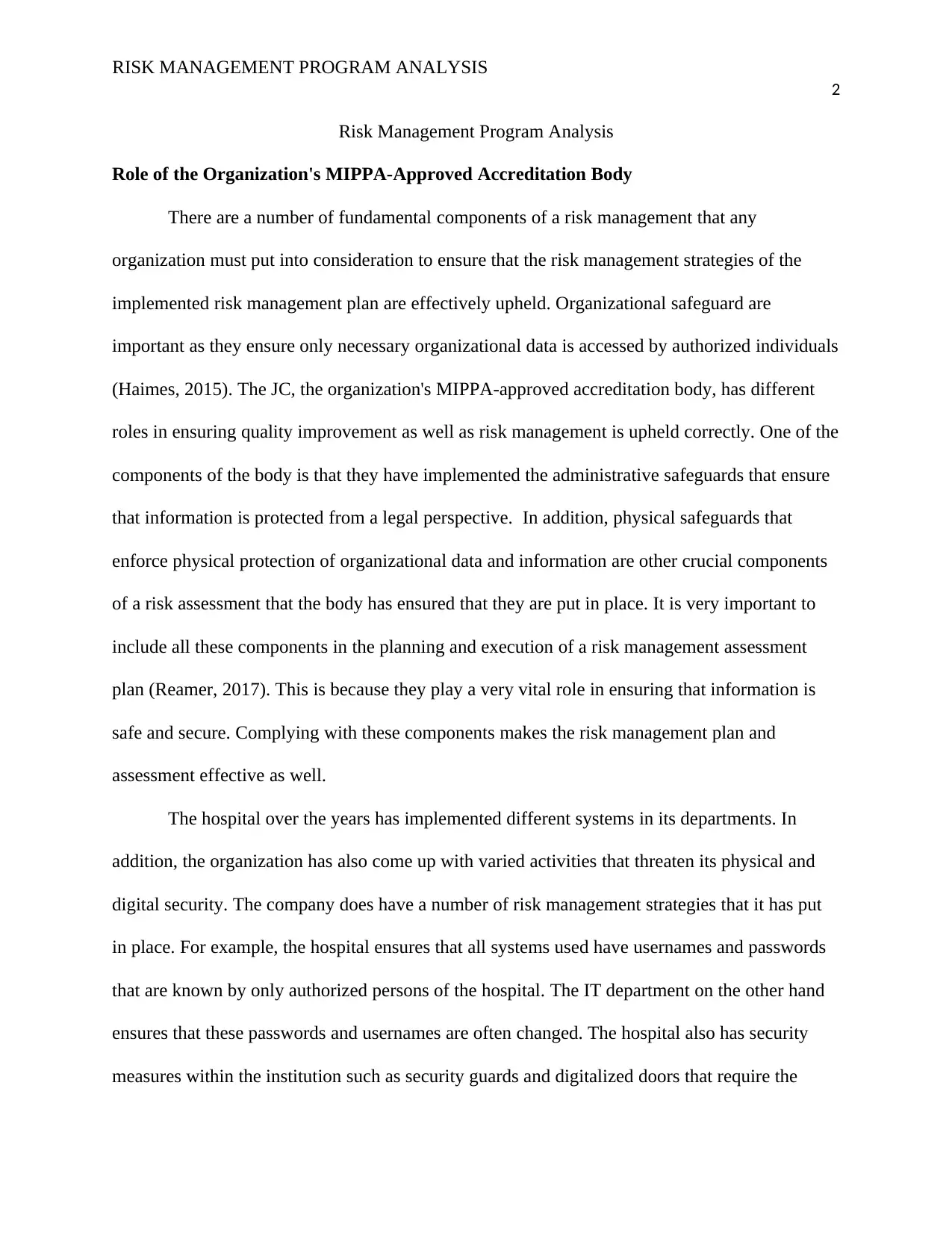
RISK MANAGEMENT PROGRAM ANALYSIS
2
Risk Management Program Analysis
Role of the Organization's MIPPA-Approved Accreditation Body
There are a number of fundamental components of a risk management that any
organization must put into consideration to ensure that the risk management strategies of the
implemented risk management plan are effectively upheld. Organizational safeguard are
important as they ensure only necessary organizational data is accessed by authorized individuals
(Haimes, 2015). The JC, the organization's MIPPA-approved accreditation body, has different
roles in ensuring quality improvement as well as risk management is upheld correctly. One of the
components of the body is that they have implemented the administrative safeguards that ensure
that information is protected from a legal perspective. In addition, physical safeguards that
enforce physical protection of organizational data and information are other crucial components
of a risk assessment that the body has ensured that they are put in place. It is very important to
include all these components in the planning and execution of a risk management assessment
plan (Reamer, 2017). This is because they play a very vital role in ensuring that information is
safe and secure. Complying with these components makes the risk management plan and
assessment effective as well.
The hospital over the years has implemented different systems in its departments. In
addition, the organization has also come up with varied activities that threaten its physical and
digital security. The company does have a number of risk management strategies that it has put
in place. For example, the hospital ensures that all systems used have usernames and passwords
that are known by only authorized persons of the hospital. The IT department on the other hand
ensures that these passwords and usernames are often changed. The hospital also has security
measures within the institution such as security guards and digitalized doors that require the
2
Risk Management Program Analysis
Role of the Organization's MIPPA-Approved Accreditation Body
There are a number of fundamental components of a risk management that any
organization must put into consideration to ensure that the risk management strategies of the
implemented risk management plan are effectively upheld. Organizational safeguard are
important as they ensure only necessary organizational data is accessed by authorized individuals
(Haimes, 2015). The JC, the organization's MIPPA-approved accreditation body, has different
roles in ensuring quality improvement as well as risk management is upheld correctly. One of the
components of the body is that they have implemented the administrative safeguards that ensure
that information is protected from a legal perspective. In addition, physical safeguards that
enforce physical protection of organizational data and information are other crucial components
of a risk assessment that the body has ensured that they are put in place. It is very important to
include all these components in the planning and execution of a risk management assessment
plan (Reamer, 2017). This is because they play a very vital role in ensuring that information is
safe and secure. Complying with these components makes the risk management plan and
assessment effective as well.
The hospital over the years has implemented different systems in its departments. In
addition, the organization has also come up with varied activities that threaten its physical and
digital security. The company does have a number of risk management strategies that it has put
in place. For example, the hospital ensures that all systems used have usernames and passwords
that are known by only authorized persons of the hospital. The IT department on the other hand
ensures that these passwords and usernames are often changed. The hospital also has security
measures within the institution such as security guards and digitalized doors that require the
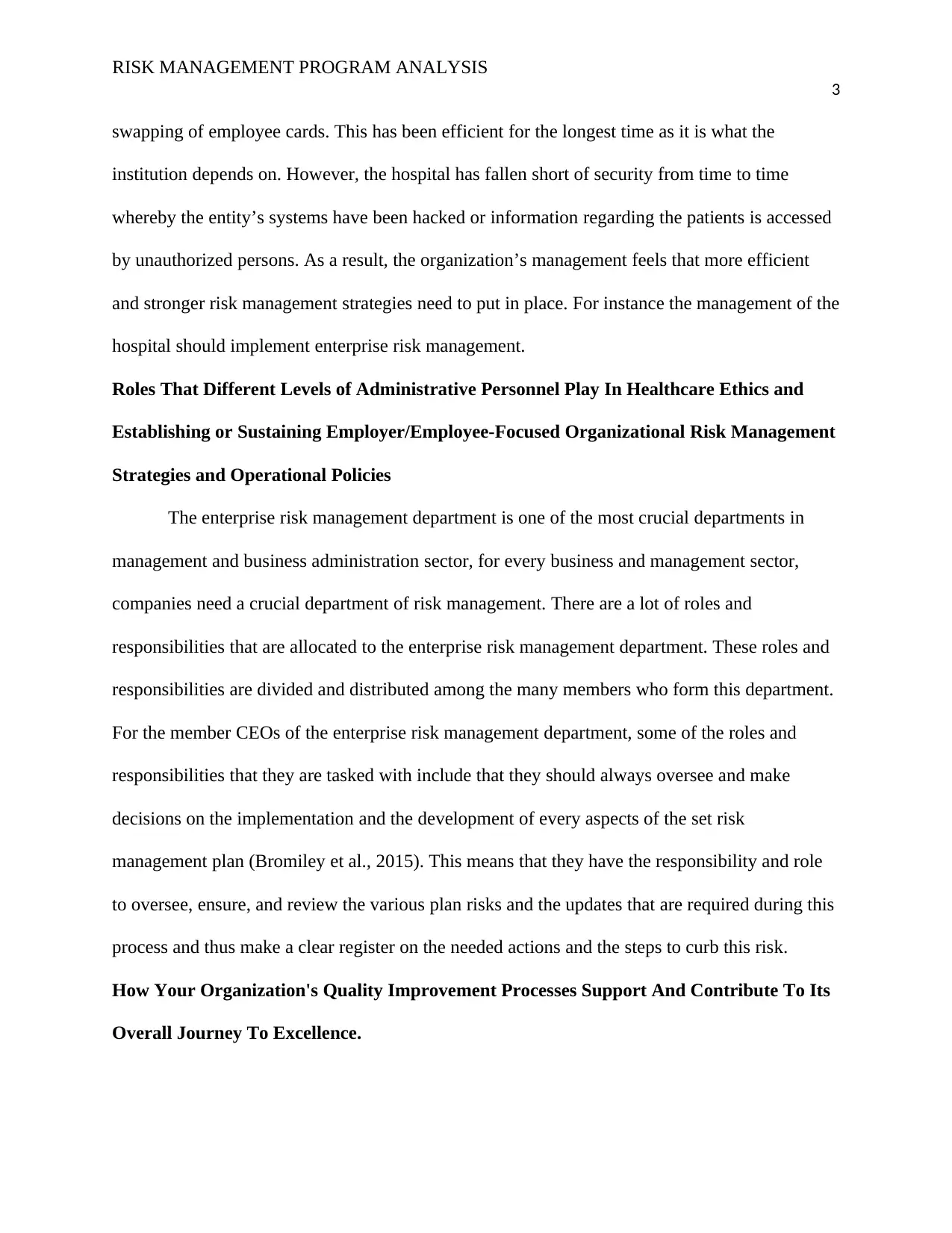
RISK MANAGEMENT PROGRAM ANALYSIS
3
swapping of employee cards. This has been efficient for the longest time as it is what the
institution depends on. However, the hospital has fallen short of security from time to time
whereby the entity’s systems have been hacked or information regarding the patients is accessed
by unauthorized persons. As a result, the organization’s management feels that more efficient
and stronger risk management strategies need to put in place. For instance the management of the
hospital should implement enterprise risk management.
Roles That Different Levels of Administrative Personnel Play In Healthcare Ethics and
Establishing or Sustaining Employer/Employee-Focused Organizational Risk Management
Strategies and Operational Policies
The enterprise risk management department is one of the most crucial departments in
management and business administration sector, for every business and management sector,
companies need a crucial department of risk management. There are a lot of roles and
responsibilities that are allocated to the enterprise risk management department. These roles and
responsibilities are divided and distributed among the many members who form this department.
For the member CEOs of the enterprise risk management department, some of the roles and
responsibilities that they are tasked with include that they should always oversee and make
decisions on the implementation and the development of every aspects of the set risk
management plan (Bromiley et al., 2015). This means that they have the responsibility and role
to oversee, ensure, and review the various plan risks and the updates that are required during this
process and thus make a clear register on the needed actions and the steps to curb this risk.
How Your Organization's Quality Improvement Processes Support And Contribute To Its
Overall Journey To Excellence.
3
swapping of employee cards. This has been efficient for the longest time as it is what the
institution depends on. However, the hospital has fallen short of security from time to time
whereby the entity’s systems have been hacked or information regarding the patients is accessed
by unauthorized persons. As a result, the organization’s management feels that more efficient
and stronger risk management strategies need to put in place. For instance the management of the
hospital should implement enterprise risk management.
Roles That Different Levels of Administrative Personnel Play In Healthcare Ethics and
Establishing or Sustaining Employer/Employee-Focused Organizational Risk Management
Strategies and Operational Policies
The enterprise risk management department is one of the most crucial departments in
management and business administration sector, for every business and management sector,
companies need a crucial department of risk management. There are a lot of roles and
responsibilities that are allocated to the enterprise risk management department. These roles and
responsibilities are divided and distributed among the many members who form this department.
For the member CEOs of the enterprise risk management department, some of the roles and
responsibilities that they are tasked with include that they should always oversee and make
decisions on the implementation and the development of every aspects of the set risk
management plan (Bromiley et al., 2015). This means that they have the responsibility and role
to oversee, ensure, and review the various plan risks and the updates that are required during this
process and thus make a clear register on the needed actions and the steps to curb this risk.
How Your Organization's Quality Improvement Processes Support And Contribute To Its
Overall Journey To Excellence.
⊘ This is a preview!⊘
Do you want full access?
Subscribe today to unlock all pages.

Trusted by 1+ million students worldwide
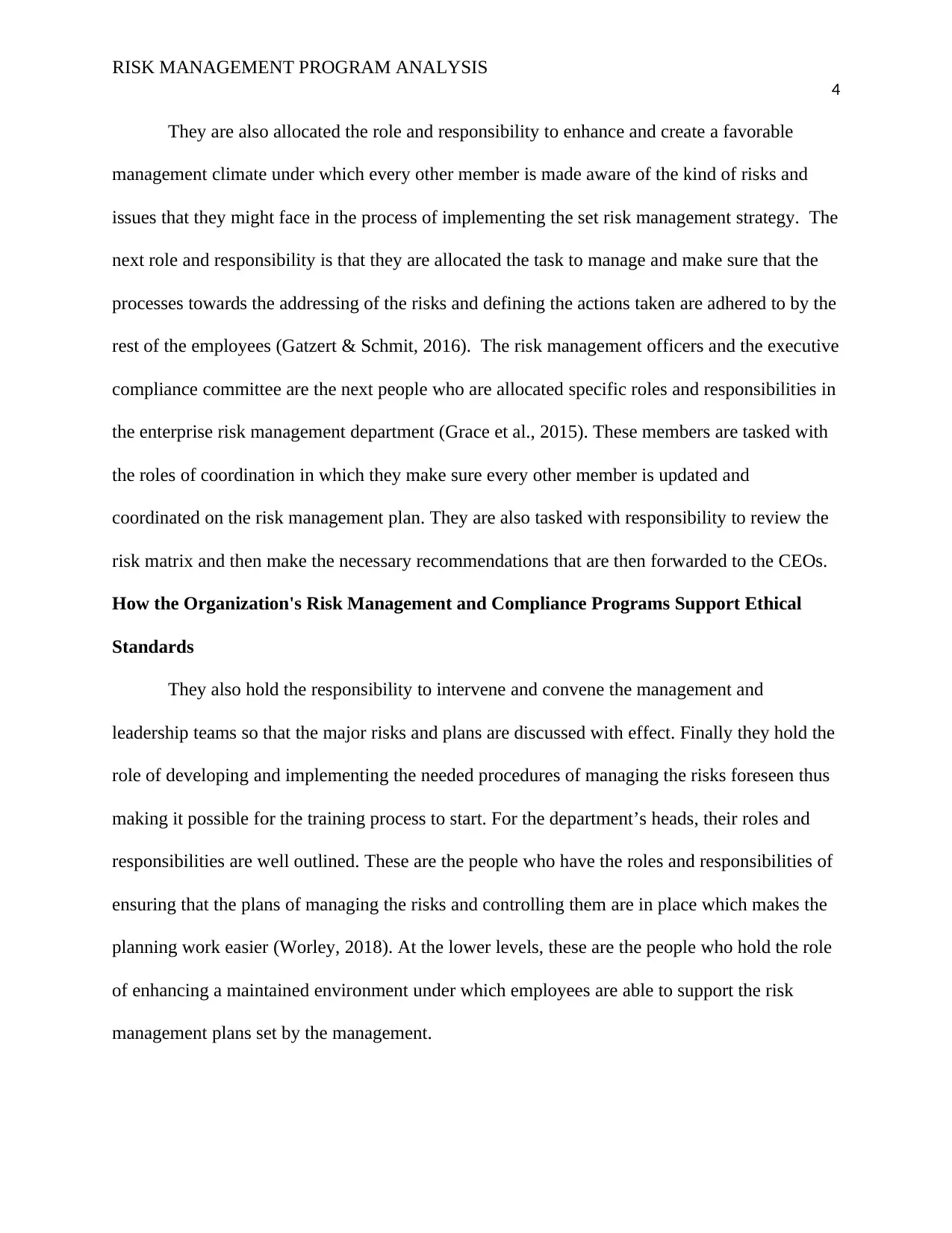
RISK MANAGEMENT PROGRAM ANALYSIS
4
They are also allocated the role and responsibility to enhance and create a favorable
management climate under which every other member is made aware of the kind of risks and
issues that they might face in the process of implementing the set risk management strategy. The
next role and responsibility is that they are allocated the task to manage and make sure that the
processes towards the addressing of the risks and defining the actions taken are adhered to by the
rest of the employees (Gatzert & Schmit, 2016). The risk management officers and the executive
compliance committee are the next people who are allocated specific roles and responsibilities in
the enterprise risk management department (Grace et al., 2015). These members are tasked with
the roles of coordination in which they make sure every other member is updated and
coordinated on the risk management plan. They are also tasked with responsibility to review the
risk matrix and then make the necessary recommendations that are then forwarded to the CEOs.
How the Organization's Risk Management and Compliance Programs Support Ethical
Standards
They also hold the responsibility to intervene and convene the management and
leadership teams so that the major risks and plans are discussed with effect. Finally they hold the
role of developing and implementing the needed procedures of managing the risks foreseen thus
making it possible for the training process to start. For the department’s heads, their roles and
responsibilities are well outlined. These are the people who have the roles and responsibilities of
ensuring that the plans of managing the risks and controlling them are in place which makes the
planning work easier (Worley, 2018). At the lower levels, these are the people who hold the role
of enhancing a maintained environment under which employees are able to support the risk
management plans set by the management.
4
They are also allocated the role and responsibility to enhance and create a favorable
management climate under which every other member is made aware of the kind of risks and
issues that they might face in the process of implementing the set risk management strategy. The
next role and responsibility is that they are allocated the task to manage and make sure that the
processes towards the addressing of the risks and defining the actions taken are adhered to by the
rest of the employees (Gatzert & Schmit, 2016). The risk management officers and the executive
compliance committee are the next people who are allocated specific roles and responsibilities in
the enterprise risk management department (Grace et al., 2015). These members are tasked with
the roles of coordination in which they make sure every other member is updated and
coordinated on the risk management plan. They are also tasked with responsibility to review the
risk matrix and then make the necessary recommendations that are then forwarded to the CEOs.
How the Organization's Risk Management and Compliance Programs Support Ethical
Standards
They also hold the responsibility to intervene and convene the management and
leadership teams so that the major risks and plans are discussed with effect. Finally they hold the
role of developing and implementing the needed procedures of managing the risks foreseen thus
making it possible for the training process to start. For the department’s heads, their roles and
responsibilities are well outlined. These are the people who have the roles and responsibilities of
ensuring that the plans of managing the risks and controlling them are in place which makes the
planning work easier (Worley, 2018). At the lower levels, these are the people who hold the role
of enhancing a maintained environment under which employees are able to support the risk
management plans set by the management.
Paraphrase This Document
Need a fresh take? Get an instant paraphrase of this document with our AI Paraphraser
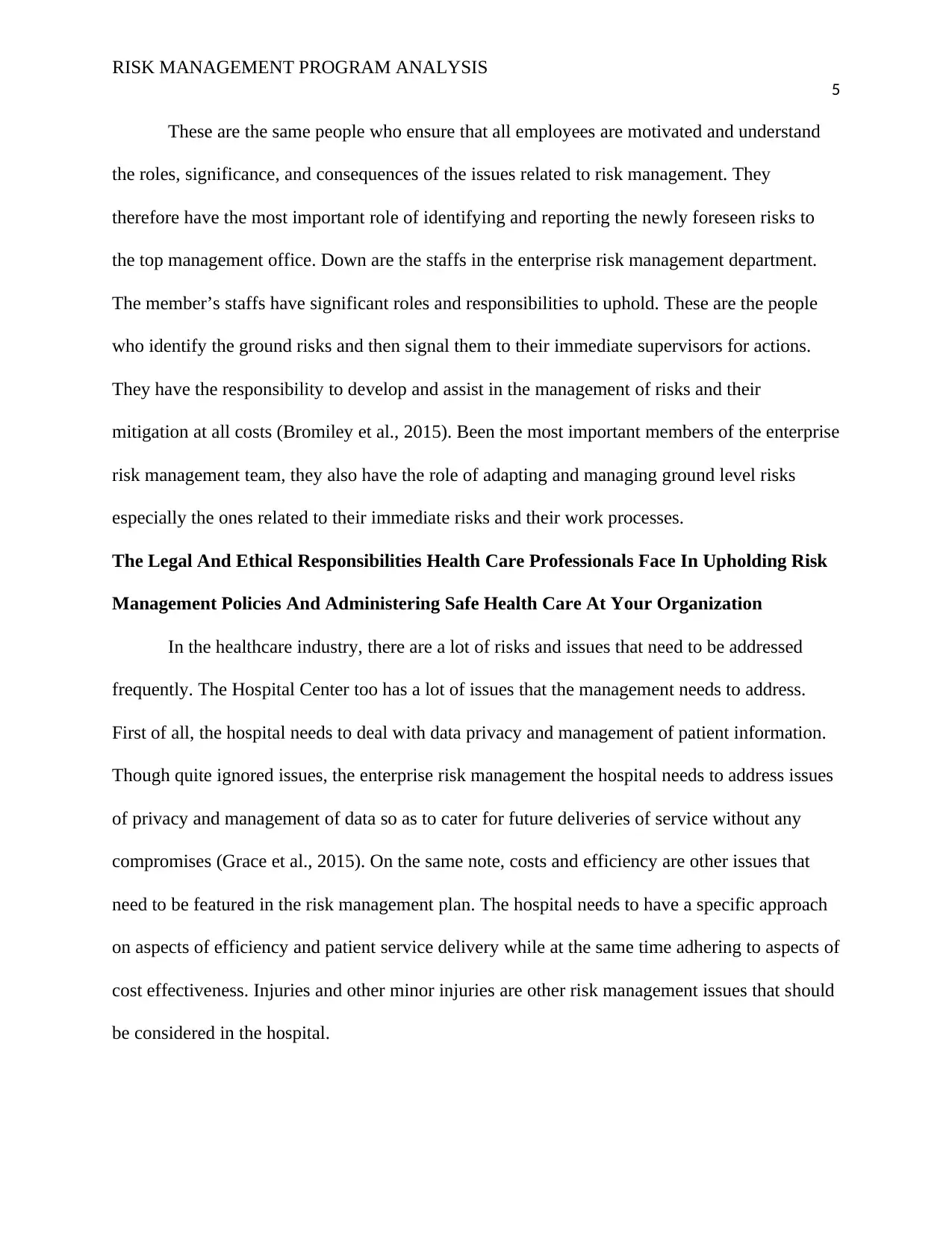
RISK MANAGEMENT PROGRAM ANALYSIS
5
These are the same people who ensure that all employees are motivated and understand
the roles, significance, and consequences of the issues related to risk management. They
therefore have the most important role of identifying and reporting the newly foreseen risks to
the top management office. Down are the staffs in the enterprise risk management department.
The member’s staffs have significant roles and responsibilities to uphold. These are the people
who identify the ground risks and then signal them to their immediate supervisors for actions.
They have the responsibility to develop and assist in the management of risks and their
mitigation at all costs (Bromiley et al., 2015). Been the most important members of the enterprise
risk management team, they also have the role of adapting and managing ground level risks
especially the ones related to their immediate risks and their work processes.
The Legal And Ethical Responsibilities Health Care Professionals Face In Upholding Risk
Management Policies And Administering Safe Health Care At Your Organization
In the healthcare industry, there are a lot of risks and issues that need to be addressed
frequently. The Hospital Center too has a lot of issues that the management needs to address.
First of all, the hospital needs to deal with data privacy and management of patient information.
Though quite ignored issues, the enterprise risk management the hospital needs to address issues
of privacy and management of data so as to cater for future deliveries of service without any
compromises (Grace et al., 2015). On the same note, costs and efficiency are other issues that
need to be featured in the risk management plan. The hospital needs to have a specific approach
on aspects of efficiency and patient service delivery while at the same time adhering to aspects of
cost effectiveness. Injuries and other minor injuries are other risk management issues that should
be considered in the hospital.
5
These are the same people who ensure that all employees are motivated and understand
the roles, significance, and consequences of the issues related to risk management. They
therefore have the most important role of identifying and reporting the newly foreseen risks to
the top management office. Down are the staffs in the enterprise risk management department.
The member’s staffs have significant roles and responsibilities to uphold. These are the people
who identify the ground risks and then signal them to their immediate supervisors for actions.
They have the responsibility to develop and assist in the management of risks and their
mitigation at all costs (Bromiley et al., 2015). Been the most important members of the enterprise
risk management team, they also have the role of adapting and managing ground level risks
especially the ones related to their immediate risks and their work processes.
The Legal And Ethical Responsibilities Health Care Professionals Face In Upholding Risk
Management Policies And Administering Safe Health Care At Your Organization
In the healthcare industry, there are a lot of risks and issues that need to be addressed
frequently. The Hospital Center too has a lot of issues that the management needs to address.
First of all, the hospital needs to deal with data privacy and management of patient information.
Though quite ignored issues, the enterprise risk management the hospital needs to address issues
of privacy and management of data so as to cater for future deliveries of service without any
compromises (Grace et al., 2015). On the same note, costs and efficiency are other issues that
need to be featured in the risk management plan. The hospital needs to have a specific approach
on aspects of efficiency and patient service delivery while at the same time adhering to aspects of
cost effectiveness. Injuries and other minor injuries are other risk management issues that should
be considered in the hospital.
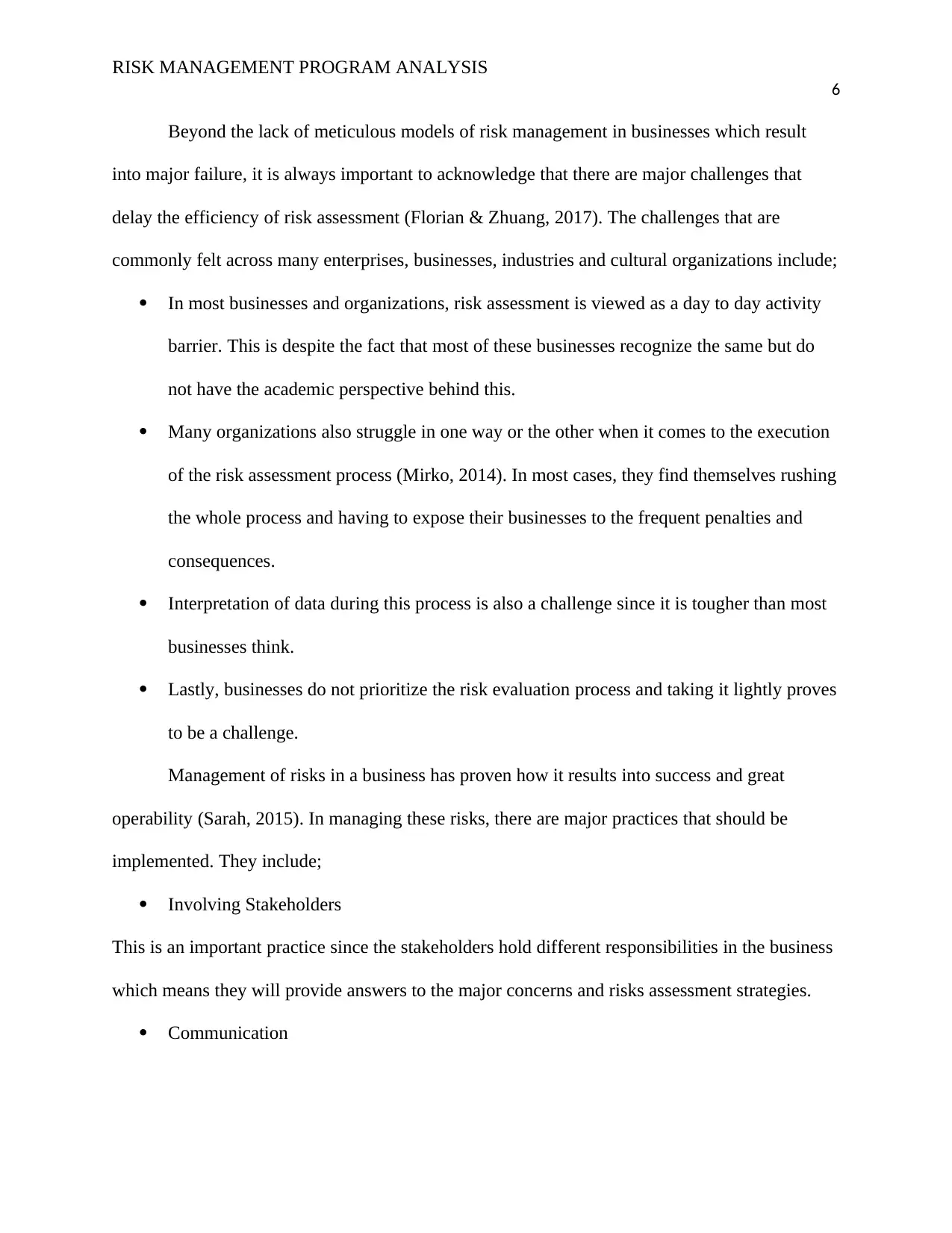
RISK MANAGEMENT PROGRAM ANALYSIS
6
Beyond the lack of meticulous models of risk management in businesses which result
into major failure, it is always important to acknowledge that there are major challenges that
delay the efficiency of risk assessment (Florian & Zhuang, 2017). The challenges that are
commonly felt across many enterprises, businesses, industries and cultural organizations include;
In most businesses and organizations, risk assessment is viewed as a day to day activity
barrier. This is despite the fact that most of these businesses recognize the same but do
not have the academic perspective behind this.
Many organizations also struggle in one way or the other when it comes to the execution
of the risk assessment process (Mirko, 2014). In most cases, they find themselves rushing
the whole process and having to expose their businesses to the frequent penalties and
consequences.
Interpretation of data during this process is also a challenge since it is tougher than most
businesses think.
Lastly, businesses do not prioritize the risk evaluation process and taking it lightly proves
to be a challenge.
Management of risks in a business has proven how it results into success and great
operability (Sarah, 2015). In managing these risks, there are major practices that should be
implemented. They include;
Involving Stakeholders
This is an important practice since the stakeholders hold different responsibilities in the business
which means they will provide answers to the major concerns and risks assessment strategies.
Communication
6
Beyond the lack of meticulous models of risk management in businesses which result
into major failure, it is always important to acknowledge that there are major challenges that
delay the efficiency of risk assessment (Florian & Zhuang, 2017). The challenges that are
commonly felt across many enterprises, businesses, industries and cultural organizations include;
In most businesses and organizations, risk assessment is viewed as a day to day activity
barrier. This is despite the fact that most of these businesses recognize the same but do
not have the academic perspective behind this.
Many organizations also struggle in one way or the other when it comes to the execution
of the risk assessment process (Mirko, 2014). In most cases, they find themselves rushing
the whole process and having to expose their businesses to the frequent penalties and
consequences.
Interpretation of data during this process is also a challenge since it is tougher than most
businesses think.
Lastly, businesses do not prioritize the risk evaluation process and taking it lightly proves
to be a challenge.
Management of risks in a business has proven how it results into success and great
operability (Sarah, 2015). In managing these risks, there are major practices that should be
implemented. They include;
Involving Stakeholders
This is an important practice since the stakeholders hold different responsibilities in the business
which means they will provide answers to the major concerns and risks assessment strategies.
Communication
⊘ This is a preview!⊘
Do you want full access?
Subscribe today to unlock all pages.

Trusted by 1+ million students worldwide
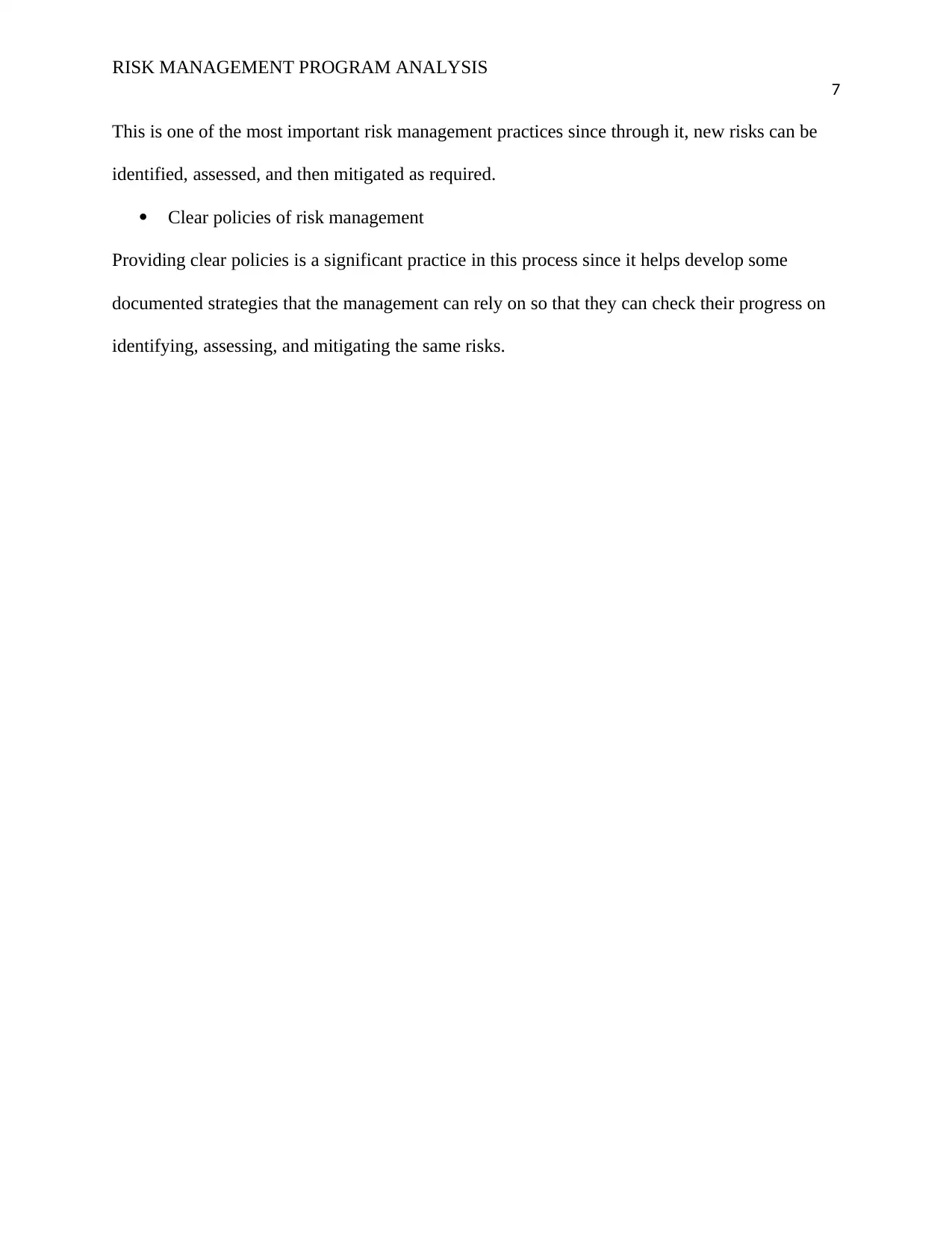
RISK MANAGEMENT PROGRAM ANALYSIS
7
This is one of the most important risk management practices since through it, new risks can be
identified, assessed, and then mitigated as required.
Clear policies of risk management
Providing clear policies is a significant practice in this process since it helps develop some
documented strategies that the management can rely on so that they can check their progress on
identifying, assessing, and mitigating the same risks.
7
This is one of the most important risk management practices since through it, new risks can be
identified, assessed, and then mitigated as required.
Clear policies of risk management
Providing clear policies is a significant practice in this process since it helps develop some
documented strategies that the management can rely on so that they can check their progress on
identifying, assessing, and mitigating the same risks.
Paraphrase This Document
Need a fresh take? Get an instant paraphrase of this document with our AI Paraphraser
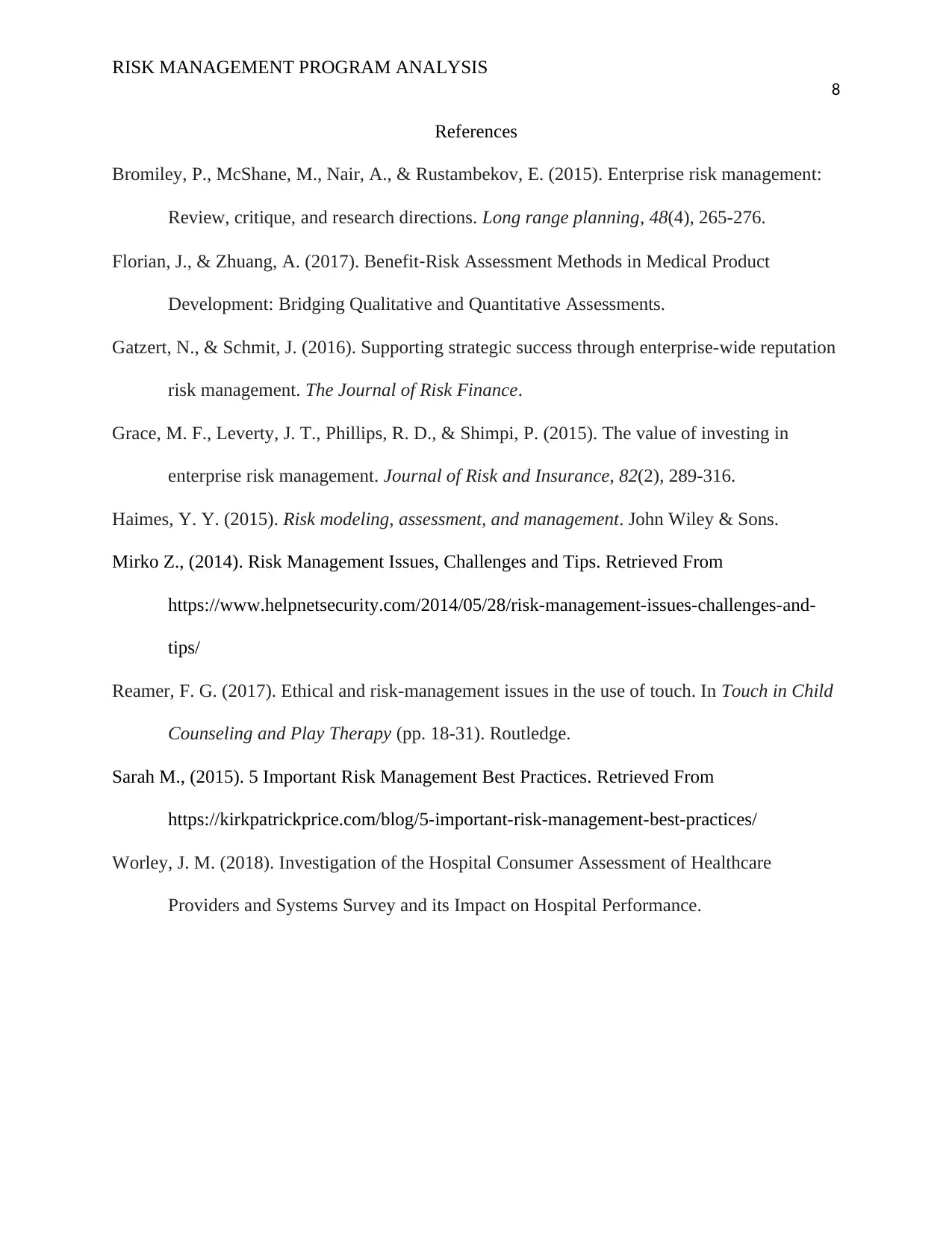
RISK MANAGEMENT PROGRAM ANALYSIS
8
References
Bromiley, P., McShane, M., Nair, A., & Rustambekov, E. (2015). Enterprise risk management:
Review, critique, and research directions. Long range planning, 48(4), 265-276.
Florian, J., & Zhuang, A. (2017). Benefit‐Risk Assessment Methods in Medical Product
Development: Bridging Qualitative and Quantitative Assessments.
Gatzert, N., & Schmit, J. (2016). Supporting strategic success through enterprise-wide reputation
risk management. The Journal of Risk Finance.
Grace, M. F., Leverty, J. T., Phillips, R. D., & Shimpi, P. (2015). The value of investing in
enterprise risk management. Journal of Risk and Insurance, 82(2), 289-316.
Haimes, Y. Y. (2015). Risk modeling, assessment, and management. John Wiley & Sons.
Mirko Z., (2014). Risk Management Issues, Challenges and Tips. Retrieved From
https://www.helpnetsecurity.com/2014/05/28/risk-management-issues-challenges-and-
tips/
Reamer, F. G. (2017). Ethical and risk-management issues in the use of touch. In Touch in Child
Counseling and Play Therapy (pp. 18-31). Routledge.
Sarah M., (2015). 5 Important Risk Management Best Practices. Retrieved From
https://kirkpatrickprice.com/blog/5-important-risk-management-best-practices/
Worley, J. M. (2018). Investigation of the Hospital Consumer Assessment of Healthcare
Providers and Systems Survey and its Impact on Hospital Performance.
8
References
Bromiley, P., McShane, M., Nair, A., & Rustambekov, E. (2015). Enterprise risk management:
Review, critique, and research directions. Long range planning, 48(4), 265-276.
Florian, J., & Zhuang, A. (2017). Benefit‐Risk Assessment Methods in Medical Product
Development: Bridging Qualitative and Quantitative Assessments.
Gatzert, N., & Schmit, J. (2016). Supporting strategic success through enterprise-wide reputation
risk management. The Journal of Risk Finance.
Grace, M. F., Leverty, J. T., Phillips, R. D., & Shimpi, P. (2015). The value of investing in
enterprise risk management. Journal of Risk and Insurance, 82(2), 289-316.
Haimes, Y. Y. (2015). Risk modeling, assessment, and management. John Wiley & Sons.
Mirko Z., (2014). Risk Management Issues, Challenges and Tips. Retrieved From
https://www.helpnetsecurity.com/2014/05/28/risk-management-issues-challenges-and-
tips/
Reamer, F. G. (2017). Ethical and risk-management issues in the use of touch. In Touch in Child
Counseling and Play Therapy (pp. 18-31). Routledge.
Sarah M., (2015). 5 Important Risk Management Best Practices. Retrieved From
https://kirkpatrickprice.com/blog/5-important-risk-management-best-practices/
Worley, J. M. (2018). Investigation of the Hospital Consumer Assessment of Healthcare
Providers and Systems Survey and its Impact on Hospital Performance.
1 out of 8
Related Documents
Your All-in-One AI-Powered Toolkit for Academic Success.
+13062052269
info@desklib.com
Available 24*7 on WhatsApp / Email
![[object Object]](/_next/static/media/star-bottom.7253800d.svg)
Unlock your academic potential
Copyright © 2020–2025 A2Z Services. All Rights Reserved. Developed and managed by ZUCOL.





